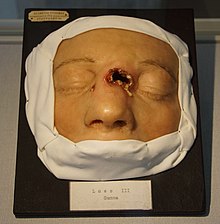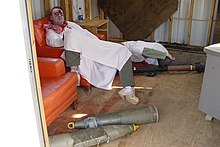Moulage
Moulage (French for 'casting' / 'moulding') is the art of applying mock injuries for the purpose of training emergency response teams and other medical and military personnel.
Moulage may be as simple as applying pre-made rubber or latex "wounds" to a healthy "patient's" limbs, chest, head, etc., or as complex as using makeup and theatre techniques to provide elements of realism (such as blood, vomitus, open fractures, etc.
The often very lifelike models are especially useful to show the students today the characteristics of rare diseases, such as skin tuberculosis or leprosy.
Giulio Cesare Casseri ("Casserius"), Spighelius, and William Harvey are other followers of the pictures of Andreas Vesalius.
The Tabulae anatomicae of Bartolomeo Eustachi ("Eustachius") (1552), printed in 1714, had a major effect on the history of anatomical wax models.
This work so affected Pope Benedict XIV that he ordered construction of a museum of anatomy in Bologna In 1742, named Ercole Lelli and featuring anatomical wax models.
Felice Fontana made cadaveric specimens into wax models by the casting method for anatomical teaching.
Wax anatomical models were first made by Gaetano Giulio Zummo (1656–1701) who first worked in Naples, then Florence, and finally Paris, where he was granted monopoly right by Louis XIV.
During the 19th century, moulage evolved into three-dimensional, realistic representations of diseased parts of the human body.
Military training utilises highly-authentic moulage techniques to desensitise to graphic wounds, prepare for battle, and treat injuries.





